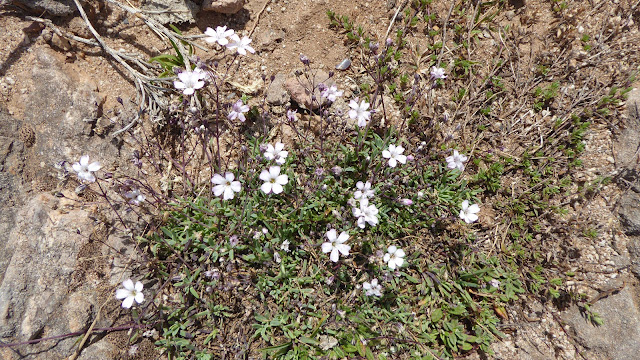The last morning and an afternoon ferry to catch from Santander a 100 km to the east. With a morning free to enjoy we drove through rain and mist (gosh that was a change in the weather!) to the
Soplao Cave.
 |
| The view from the van when we woke up at Vidiago on our last morning |
The cave is in the hills inland from the coast though pretty well on our route and through all that dampness we saw a different side of Spain - more like England!
The cave was discovered by the "La Florida" miners at the beginning of the 20th century and they, realising the tourist value, didn't damage it in their search for the zinc and lead ore as they might otherwise have done but opened it to the public. There are 20 km of tunnels in all some open to the public and more to "adventure tourists".
We arrived early, and were later glad when we saw the queues that were forming later in the morning (wet day = don't go on the beach!). There is a small train which take you to the cave - could have done with something like this at Segobriga! - and then a guided tour of a kilometre or so.
 |
| Departing for the mine |
 |
| Smile Jan! |
 |
| A glimpse of an old drift leading into the cave |
 |
| Heading into the caves |
Unfortunately no photography is allowed in the cave but there are some fantastic pictures on their
website (look under "galeria" at "formations"). Some of the most amazing "eccentric" stalactites I've ever seen, in particular. I had to make do with some postcards.
After a coffee and a bun.... might be our last opportunity.... we wandered back outside towards the van, detouring past this Asturian miner who was just asking to have his photo taken:
Nearing the van... "Oh blow", said Jan, "I left the lights on". And it was "oh blow" too, not a peep out of the battery! First of all we tried the breakdown company - no record of renewal... terribly sorry but she couldn't help. Nobody around in the car park, so we headed back - ticket office was no go - besieged by a lengthy queue of visitors waiting for tickets; we tried the shop... she didn't know any local garages open on a Sunday - perhaps tomorrow? We explained we had a ferry to catch but although she was very sorry for our predicament she couldn't help.
Then we tried fluttering our eyelashes at a chap sweeping the cafeteria floor... our battery was flat... would he be so kind as to give our camper van a little push please? The damsels in distress bit worked really well, he and I pushed, Jan jump started it, others in the car park made sure nothing was in the way of our downhill run, I jumped in and we were off!
All downhill from here... well to the motorway anyway... and 80 km to the Ferry Port gave the battery a good charge. It even started OK again the next evening when we arrived in Portsmouth!
 |
| Adios Santander! |
 |
| Bonjour France! |
 |
| Somehow the coffee isn't the same out of a paper mug... the pain au chocolat was OK though! |
In Pompey around 10pm, we drove on through the night - such lovely empty roads! - to home.
NEXT.... the two old bats, still on the loose, head north....
































































